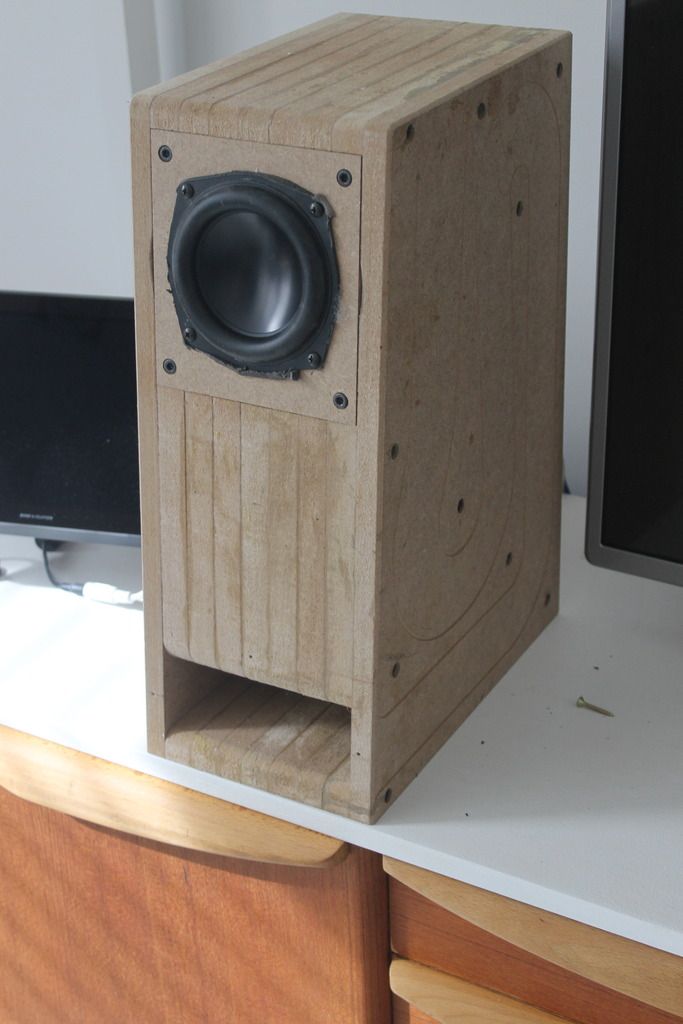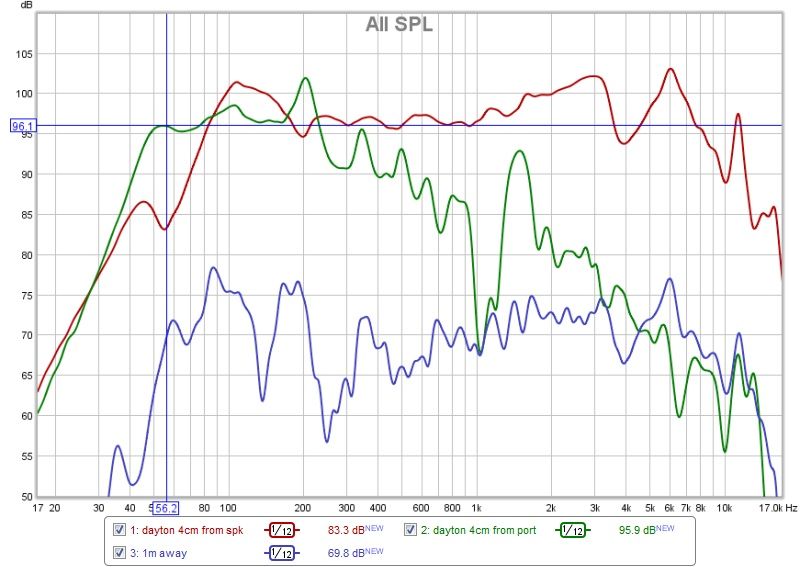Is the volume the same?
The combined looks like a very similar curve only shifted due to a volume change.
Nothing changed just the adaptor for the ML TL
OK, thats odd usually the mid-high freq should not change unless the distance to the mic has changed or the volume has changed.Nothing changed just the adaptor for the ML TL
The distribution between driver and port will change, that's evident in the graphs. Its very hard to visually add curves that differ significantly and are logarithmic (db) because 80db+65db=approx 80db because a signal at -15db difference is only adding 3.1% so its very little.
I would pick the TL all else equal. Odd still, the driver output levels are very close >200Hz but the combined output shifted?
It'll interesting what you think from listening.
Last edited:
Yes, but they have different frequency axis so its hard to visually compare, and the volume appears to have shifted. The port / driver distribution is different, thats OK, I look at the dominant signal of the two at a given freq when trying to visually combine outputs. The mid and high freq should not be affected by the tuning.Are we looking at the same graphs?!
There's clearly a huge drop in output from the port above 100Hz with the ML-TL adapter in place.
The bass tuning also appears to have gone down half an octave.
Chris
The LF extension (1/2 octave) I do not believe. Even 50Hz from this driver is amazing, and with a 1.2M pipe its unlikely to produce 30Hz. Thats from something else in the room.
The combined response graph that has both MLTL and TL is more like I would expect, very similar. Except the volume shift is unexpected.
Last edited:
LOL, are you suggesting its a "sow's ear"?Not yet a silk purse, I'd posit
Dayton ND105-4 test
Think that shift was due to me accidentally putting the volume up!
Anyway thought you would find this interesting, thought id change the driver to one i had laying around.
This is a Dayton nd105-4.

The readings




OK, thats odd usually the mid-high freq should not change unless the distance to the mic has changed or the volume has changed.
The distribution between driver and port will change, that's evident in the graphs. Its very hard to visually add curves that differ significantly and are logarithmic (db) because 80db+65db=approx 80db because a signal at -15db difference is only adding 3.1% so its very little.
I would pick the TL all else equal. Odd still, the driver output levels are very close >200Hz but the combined output shifted?
It'll interesting what you think from listening.
Think that shift was due to me accidentally putting the volume up!
Anyway thought you would find this interesting, thought id change the driver to one i had laying around.
This is a Dayton nd105-4.

The readings




LOL, are you suggesting its a "sow's ear"?
Didn't sound right the MLTL conversion, the music sounded restricted in a way when the volume was pumped up, some songs made it feel like the speaker was under pressure.
Definitely needed to breathe more, the bass and mids sounded muffled, soon as i took off the adaptor plate it sounded soooo much better.
What you're describing might be what some people refer to as "boxy". I've heard its a reason some people to go TLs and horns.Didn't sound right the MLTL conversion, the music sounded restricted in a way when the volume was pumped up, some songs made it feel like the speaker was under pressure.
Definitely needed to breathe more, the bass and mids sounded muffled, soon as i took off the adaptor plate it sounded soooo much better.
However, its clear from the graphs that the enclosure design and room are dominating the LF performance. Just as it should be. This might be this is as good as it gets with this enclosure design. The HF ripples will go when damping is added.
I'm currently planning enclosure#4 for bass response in my Omni and it's a TL design. I'll be interesting to compare notes to the other 3 designs, and yours, when using the same driver and XO.
Think that shift was due to me accidentally putting the volume up!
Anyway thought you would find this interesting, thought id change the driver to one i had laying around.
This is a Dayton nd105-4.
The readings
---------------------------------------------------------
Vishalk, you are a gold mine of data.
The same enclosure, significantly different driver (Dayton MidBass) and the results are similar for LF. This indicates the enclosure and room are dominating them. The FR Alpair performance beats the specialized Dayton everywhere, that is an amazing driver.
I'm assuming there is a difference volume that caused the shift because both drivers are approx 85db/W.
Even thought the results are "similar" at LF and MF (volume adjusted). How did the sound compare? There is very little music power above 10KHz but the Dayton's ripple in 4-10Khz may be audible.
Last edited:
Got any bright ideas for the Alpairs yet? Like I said before, I think they deserve a far better enclosure than the MDF "TL" , and the time and expense involved in finding a working pair nearby would be a wise investment.
Chris this all for fun and learning
But yes i am going to build and try a different enclosure.
My thinking was to build these
Slim Classic GR dMar-Ken7.3 2v03
http://www.frugal-phile.com/boxlib/P10free/CGR-dMar-Ken73-190216.pdf
I will also build a simple bass reflex box
Alpair 7 Gold | Markaudio
Ill do the bass reflex one first as its a simple build.
The main aim is to find which enclosure suits my listening needs and gives me the performance i desire based on listening and using REW for measurements.
Think that shift was due to me accidentally putting the volume up!
Anyway thought you would find this interesting, thought id change the driver to one i had laying around.
This is a Dayton nd105-4.
The readings
---------------------------------------------------------
Vishalk, you are a gold mine of data.
The same enclosure, significantly different driver (Dayton MidBass) and the results are similar for LF. This indicates the enclosure and room are dominating them. The FR Alpair performance beats the specialized Dayton everywhere, that is an amazing driver.
I'm assuming there is a difference volume that caused the shift because both drivers are approx 85db/W.
Even thought the results are "similar" at LF and MF (volume adjusted). How did the sound compare? There is very little music power above 10KHz but the Dayton's ripple in 4-10Khz may be audible.
Thanks DonV i do like to test and provide DataI did this to indicate the characteristics of the box and room and show that different drivers would or wouldn't have a similar effect.
You are correct in saying that Alpairs smash the daytons out of the water, no comparison Don in both sound and build quality.
Last edited:
Hopefully, you'll post more data on the new enclosureThanks DonV i do like to test and provide DataI did this to indicate the characteristics of the box and room and show that different drivers would or wouldn't have a similar effect.
You are correct in saying that Alpairs smash the daytons out of the water, no comparison Don in both sound and build quality.Its always reassuring when the objective measurement agrees with the subjective comparison.
You'll be in the enviable position to compare two radically different designs with the same driver. Assuming the saw doesn't reach the TLs.
BTW - the best materials to build with are composites (MDF, Particle, maybe Ply) as they have minimum resonances. Sadly they are also the ugliest unless you veneer them.
BTW - the best materials to build with are composites (MDF, Particle, maybe Ply) as they have minimum resonances. Sadly they are also the ugliest unless you veneer them.
Or combination of different materials that resonate at different frequencies.
I'm playing with plywood, aluminium and stone layers lately.
Especially stone.. it can give quite a stunning look. Something different, for sure... I like being different.
Totally agree. How do you account for different expansion rates of these materials ?Or combination of different materials that resonate at different frequencies.
I'm playing with plywood, aluminium and stone layers lately.
Especially stone.. it can give quite a stunning look. Something different, for sure... I like being different.
Well,... unless you bring them outside in winter -30C freezing temperature, then inside to +25C in a matter of minutes... that would probably cause problems to most kinds of speakers construction anyway!
I'm using epoxy to bond each layer, and so far, it's been ok. Also, I try to keep each layer at a minimum, so interactions are minimal. 6 to 8mm plywood, 4mm aluminium, 6mm stone.
But we do not have freezing temperatures around here! Coldest we get in winter is 12C. Summers are 35+C
I'm using epoxy to bond each layer, and so far, it's been ok. Also, I try to keep each layer at a minimum, so interactions are minimal. 6 to 8mm plywood, 4mm aluminium, 6mm stone.
But we do not have freezing temperatures around here! Coldest we get in winter is 12C. Summers are 35+C
Funny, but not exactly what I was meaning.Well,... unless you bring them outside in winter -30C freezing temperature, then inside to +25C in a matter of minutes... that would probably cause problems to most kinds of speakers construction anyway!
I'm using epoxy to bond each layer, and so far, it's been ok. Also, I try to keep each layer at a minimum, so interactions are minimal. 6 to 8mm plywood, 4mm aluminium, 6mm stone.
But we do not have freezing temperatures around here! Coldest we get in winter is 12C. Summers are 35+C
There are temperature related expansions and well as humidity related expansions (more likely). Humidity can vary from 20% RH right up to 90%RH causing the wood to change dimension. The metal and stone are immune to this.
But we do not have freezing temperatures around here! Coldest we get in winter is 12C. Summers are 35+C
It's the same here......
Funny, but not exactly what I was meaning.
There are temperature related expansions and well as humidity related expansions (more likely). Humidity can vary from 20% RH right up to 90%RH causing the wood to change dimension. The metal and stone are immune to this.
That's why I thought you were relating to temperature expansion.
Wood, as in plywood that I'm using, with the layers of bonded plies, is less susceptible than a solid piece of wood.
The most troublesome combination would have been the plywood-onyx combination, but that has withstood 6 months of temperature and humidity changes without ill-effect. Onyx, being a crystal-like stone, gets easily cracked when outside forces are applied. Yet, my boxes are fine so far.
If added protection was needed between the wood and stone, a layer of aluminium could be bonded in-between.
- Status
- This old topic is closed. If you want to reopen this topic, contact a moderator using the "Report Post" button.
- Home
- Loudspeakers
- Full Range
- Transmission Line Speaker Build using Alpair 7.3 speakers, first build.